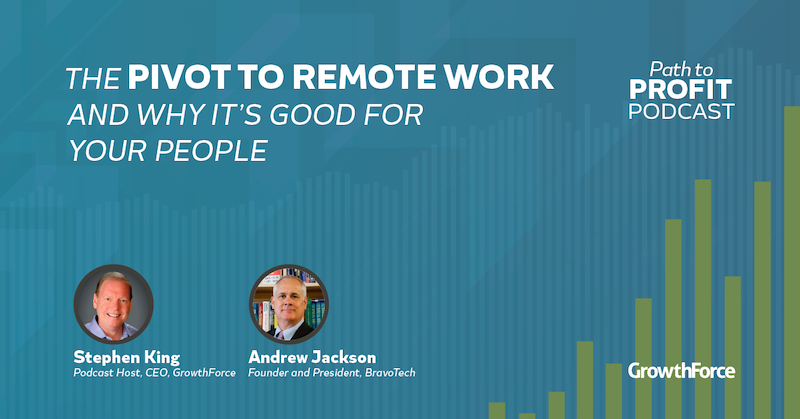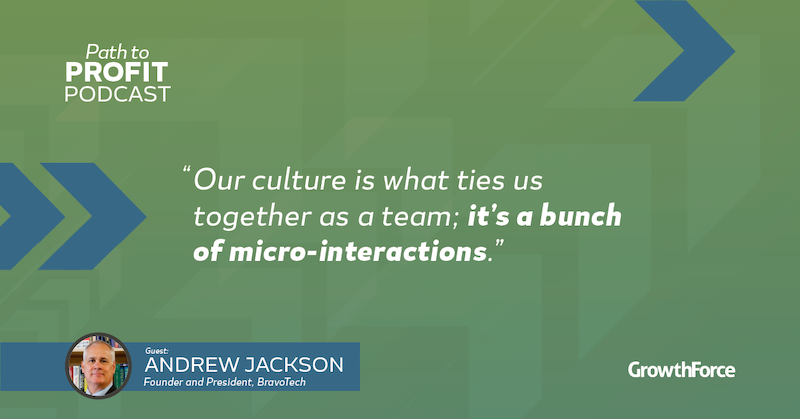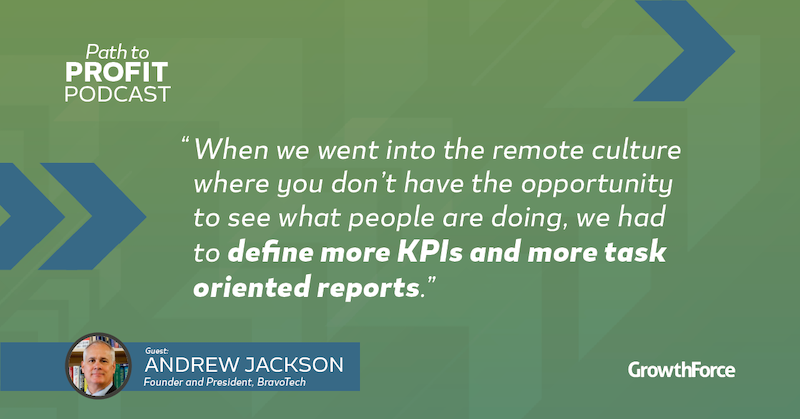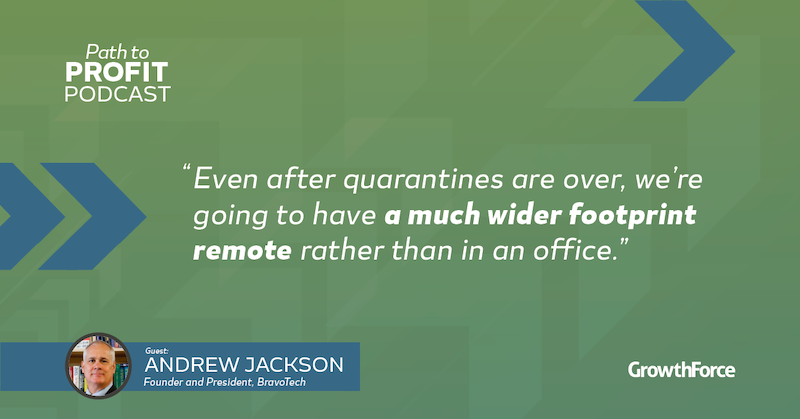8 min read 

We know what you’re thinking- another article about remote work. But this is different. We’re here to talk about a part of remote work life that most business owners overlook, and can’t correct until it’s too late.
|
Key Takeaways
|
Culture. If remote work is going to be sustainable, it needs to become more than just work: it needs to be a conduit of culture.
In this episode of the Path To Profit Podcast, GrowthForce CEO, Stephen King talks with Andrew Jackson, founder and president of BravoTech, to discuss how to maintain and encourage a healthy company culture in a remote environment.
Jackson provides practical tips on how to implement a healthy remote culture, and how it can help increase a company’s reach and drive growth.
→ Listen to the full episode here! 🎙
How to maintain a healthy culture in a remote environment (& how to make it fun)
What does culture mean to you and how are you dealing with this in a remote world?
“Culture is what ties us together as a team. It’s the combination of a whole bunch of small micro-interactions.” Jackson explained. “Pre-pandemic there were so many chances for employees to engage with another- passing in the hallway, a water cooler discussion- but all of these impromptu interactions went away.”

Jackson suggested the first step is finding the right technology to support your team’s remote environment. It’s important employees have an easy way to communicate internally with team members on both video and instant text chat features. This is an easy way to make sure everyone is staying connected and for bridging the gap to feel more connected with their team.
💡 TIP: For companies that have Microsoft 365, the Microsoft Team chat feature is free - including both the chat tool and videos. Being able to immediately connect with someone visually and audibly makes the transition to remote working more seamless and takes away the feeling of separation. Zoom and Microsoft Teams have been taking the lead in video chat.
However, while technology may enable employee interactions, it still only acts as a vessel of communication- it’s up to its users on how they’ll use it. Going one step further beyond transactional meetings, Jackson shared how he has been able to get creative with finding new ways for his team to connect.
“The next thing we started to do was plan video meetings with a dedicated topic to encourage interaction,” Jackson explained. “One of our best ones was a scavenger hunt. We had everyone break into groups, and you were given a prompt to go find an item or object around the house. For example, one was ‘find a picture from a family vacation’, and people would break off to go find a picture of themselves with their family.”
Jackson continued, “It really brought us together- even more so than if we were in the office because they had access to all those personal items that were at their house.”
But, why is this so important?
“If you don't have culture, what's binding your team together? What's keeping some third party from coming in and recruiting your people away?” Jackson emphasized.
Culture keeps your company together and makes people feel grounded. You have the power to create a positive, rewarding workplace for your employees. When a company lacks an effective human capital strategy, it also tends to lack happy, fulfilled, and motivated employees. As a result, employees are less productive overall.
How managers can use KPIs to track remote employees
Moving onto the business side of the equation- how are you able to monitor and measure success while being remote?
“When we started this company, I often found myself saying- I don't care about how you get the work done. I just want the end result,” Jackson stated. “However, when we went into the remote workplace where we don't physically see everyone every day, and we don't have the opportunity to see what employees are doing, we had to define more KPIs, and look at more task-oriented reports.”
Jackson continued, “We start with a daily huddle- every day we get together on Zoom. We use this time to see each other and everybody can give an update on what they are currently working on.”

“But we've realized, especially for the junior employees, people need to know they are going to be held responsible for daily activities. So we switched to KPI-based management. We built specific KPIs so employees have activity-based management, as well as results-based management,” Jackson said.
“It's been working really well. It took a little bit of time for people to understand why we're doing it, and understand it was for their advantage as well, but now it’s a win-win.”
It’s very helpful to have an operating framework to help everyone stay aligned and for the company to run smoothly. Defined simply, an operating framework is a strategy that a business uses to unify, motivate, orient, and organize its people around a common vision to achieve predefined goals within a set timeframe.
Digging a little deeper, what KPIs do you specifically look at and track?
“We game-ify it, where we give values to different activities,” Jackson said.
For example, Jackson explained, “If you do a lower level activity, it might be one point. If you do an activity where you engage a customer, it might be five points. If you move the engagement to the point where we have an opportunity to provide a service, it might be 10 points.”
“Everyday, in our management huddle, every employees’ total scores are shared, so people know where everyone stands.” Jackson continued, “At the end of the week, we have our MVP. When we were in the office, we would give out an MVP trophy.”
But since times have changed, Jackson has found new ways to reward employees: “We designed an MVP background to use on Zoom meetings. Now, the winner gets a virtual background that’s bright, shiny with lots of stars. They get to use it for the week after being declared MVP.”
Taking this one step further, Jackson noted the effectiveness of team-based recognition.
Another advantage of using KPI-based management allows leadership to reward the entire time based on individual team member’s achievements.
Society of Human Resource Managers found that businesses with employee recognition programs saw a 63% increase in employee productivity and a 58% return on their profit margins.
Applying this concept to the team level not only encourages productivity but fuels team engagement. “We’ve implemented a team-based recognition program,” Jackson explains, “When a team member reaches their target numbers, on Friday, the entire team gets to leave early. Everybody gets excited!”
But do people respond well to this metric-based management style? Is there any pushback?
“People that are reaching the numbers don't mind you keeping track of them. It’s the people that are not reaching the numbers that mind the most. And now, you've put the spotlight on something you need to address anyways.” Jackson said.
Whether in-office or remote, focus on designing an effective human capital strategy that ensures your employees feel valued, are fairly compensated, are recognized for their achievements, and have plenty of opportunities for career development and advancement.
Core Values: The Foundation Of Company Culture
It starts at the top- if you don't take the time to define your core values, it's going to get created without you. Driving alignment between an organization's values and employee's roles within the organization should be a focal point of your management strategy.
What are the behaviors and core values of your company?
Jackson alluded to Lencioni's book: The Ideal Team Player: How to Recognize and Cultivate The Three Essential Virtues. “We want our team members to exhibit 3 traits: humble, hungry, and smart.”
Jackson breaks it down:
Humble: “Team members that don’t have an “all about me” mentality, and don't have to get all the accolades.”
Hungry: “Employees that are always asking for the next thing, focused on the metrics, and want to do more. People who are also there to help the team succeed.”
Smart: “Not necessarily academic smart. Using your ears and your mouth in the right percentage, and sometimes that means listening more than talking".
Jackson added an important addition to Lencioni’s 3 values: Grit. “In our industry, or any sales-based industry, you're going to get a lot of rejection and hear a lot of nos. You’ll have to brush yourself off and get back to work”.
Hire for behavior, not skills. Once your company’s core values are defined, you now know what to look for when hiring new employees. The biggest mistake small businesses make is recruiting for the skills to pay the bills instead of recruiting for the behaviors that will allow an employee to succeed.
Looking Ahead: Post Pandemic Life
Although the pandemic has brought on a handful of challenges, it has also opened new doors. The remote environment breaks geographical barriers and welcomes new customer opportunities, as sales teams are no longer pigeon-holed by physical locations.
“After the pandemic, we're anticipating having a much bigger footprint remote than in an office,” Jackson added.
That being said, the changes made today will set the tone for a better future.

Looking forward, Jackson plans to shift towards “meeting-based management”- still keeping remote teams, but holding functional, in-person meetings to bring employees back together.
When it comes to company culture, the first impression is a lasting one. “When it comes to new hires getting acquainted and their feet wet into the company culture, we’d like to keep onboarding and training in-office,” Jackson added.
Stay ahead of the curve, capitalize on these opportunities now and your bottom line will thank you in the years to come.
Focus On Leading- Not Mundane Back Office Issues
A healthy human capital and financial management strategy are not mutually exclusive. You need both to avoid the pitfalls of poor leadership and the costs of high employee turnover, lagging productivity, and missed opportunities.
Consider transitioning to an outsourced, back-office solution to help free up your plate, so you focus on what you do best: driving your business forward to success. Outsourcing your finance function means you will no longer be hindered by your company's financial processes. Instead, you'll be able to spend your time the way the most productive business leaders do.


